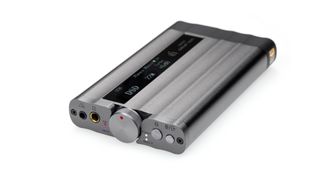Following a recent glowing five-star review for its diminutive iFi Go Blu portable DAC/headphone amp, iFi has updated its midrange x-series lineup with the xDSD Gryphon model. The portable DAC/amp with Bluetooth builds upon the firm's 2018-released iFi xDSD DAC/digital headphone amp and iFi xCAN analogue headphone amp with Bluetooth.
iFi says the xDSD Gryphon is its most ambitious portable DAC/amp yet, combining the functionality of both outgoing models with redesigned circuitry that elevates performance to the next level.
Retaining the contoured design of its older silblings (although a little larger, and weighing 215g), it is still sufficiently compact to stow away in a small bag or to look modest on a desktop, and that extra chassis space is fully utilised by the entirely re-engineered tech within. iFi also says that its gunmetal grey finish is less prone to fingerprints than the glossy dark titanium of the original xDSD and xCAN, too.

Key to the xDSD Gryphon’s flexibility is the breadth of equipment you can connect it to. Digital and analogue cable inputs are provided – the former in USB and S/PDIF flavours, the latter via balanced 4.4mm Pentaconn and single-ended 3.5mm sockets (which double as both inputs and outputs: inputs when the xDSD Gryphon is being used as an analogue headphone amp; outputs when used as a DAC/preamp in a home audio system, with fixed and variable options to connect to an amp and speakers). Bluetooth 5.1 reception is also onboard. At the back, the xDSD Gryphon sports two USB–C ports– one input for digital audio, handled asynchronously, and the other for charging.
At the front, a pair of headphone outputs are provided – a 3.5mm socket and a 4.4mm Pentaconn, enabling headphones equipped with balanced connectivity to take full advantage of the xDSD Gryphon’s balanced amp design. The 3.5mm output benefits from iFi’s S-Balanced circuitry, which promises to cut crosstalk and related distortion in half when used with regular, single-ended headphone connections too.
Built into the top surface is an OLED display strip, showing information including input selection, volume level, battery level, digital audio format and sample rate and settings.
The xDSD Gryphon’s digital engine is based around the Burr-Brown DAC chipset that iFi uses extensively, plus the XMOS chip to process the audio data received via the USB and S/PDIF digital inputs. The xDSD Gryphon uses a low-latency, 16-core XMOS microcontroller promising enhanced processing power – indeed, the iFi team programmed the XMOS firmware itself.
Extensive jitter-eradication technologies are also applied to the digital stage, including the latest generation of iFi’s GMT (Global Master Timing) femto-precision clock and intelligent memory buffer.
Hi-res audio support is certainly on offer, too. The xDSD Gryphon handles PCM files to 32-bit/768kHz, all levels of DSD to DSD512, and single- and double-speed DXD. PCM and DSD take separate pathways, thus enabling data to remain ‘bit-perfect’ in their native forms right through to analogue conversion.
MQA (the hi-res streaming technology that underpins Tidal’s Masters streams) is also supported through the USB and S/PDIF inputs, with full decoding of MQA files up to 384kHz. Here, the full ‘three unfold’ decoding process is performed internally, as opposed to only the final unfold in the manner of an MQA ‘renderer’.
Making full use of Qualcomm’s latest four-core QCC5100 Bluetooth processing chip, every current high-definition Bluetooth audio format is supported, including aptX Adaptive and aptX HD, LDAC and HWA/LHDC. Other codecs covered include regular aptX and aptX Low Latency, AAC and SBC (the ‘plain vanilla’ Bluetooth codec). Up to seven paired Bluetooth source devices can be stored in memory too.

The xDSD Gryphon is the smallest and most affordable device to feature iFi's PureWave analogue circuitry design, the firm's most advanced, symmetrical dual-mono circuit topologies normally found in its premium-level devices (including the flagship Diablo portable DAC/amp).
In terms of oomph, the headphone amp stage boasts a continuous power output of more than 1000mW into a 32-ohm load available through the balanced headphone socket.
iFi has also developed a new configuration called OptimaLoop – a negative feedback system that the company claims is more accurate than the usual approach. It incorporates multiple feedback paths (instead of one global loop) where each path is optimised for a particular function and works synergistically with the others to deliver optimal overall performance.
The xDSD Gryphon features something called CyberSync, a redesign of the software-driven CyberDrive volume control featured in the original xDSD. Uniquely, iFi’s CyberSync volume control promises perfect volume sync between the source and the DAC. It detects which operating system the DAC is connected to – iOS, Android, Windows, Mac OS or Linux – and instructs the source’s OS to bypass its software volume control. Whether volume is adjusted using the xDSD Gryphon’s rotary control or on the source device, CyberSync ensures the change is performed purely by the Gryphon’s analogue control chip.
Users can choose between three bespoke digital filters when listening to digital sources via the on-screen menu: Bit-Perfect, Standard and GTO (Gibbs Transient Optimised), each boasting a fine-tuning effect on sound. XBass and XSpace profiles are familiar to users of other iFi DAC/amps, but like the xCAN before it, the xDSD Gryphon sports an expanded version called XBass II, offering three separate headphone EQ options: ‘Bass’ (which targets low frequencies), ‘Presence’ (which focuses on the upper midrange) and ‘Bass + Presence’ (which implements both together).
A further switch on the base of the xDSD Gryphon engages IEMatch, another proprietary iFi circuit that attenuates the headphone output to better suit high-sensitivity headphones, removing potential background noise and increasing the usable volume range.
The iFi xDSD Gryphon will be available from mid-November with an RRP of £599 / AU$699 (roughly $815).
MORE:
Read our extensive collection of iFi reviews
See also, DACs: what is a DAC? And do you need one?
Consult our roundup of the best DACs 2021: USB, portable and desktop DACs
